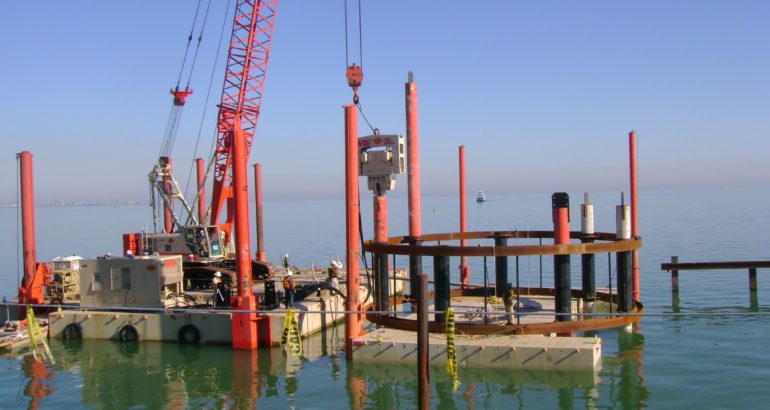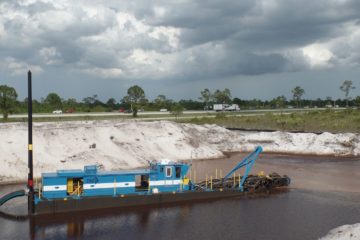Most marine construction activities that are performed above
water can be performed below water. Environmental
conditions and regulatory constraints at the site will often
dictate the most functional and cost-effective method to perform the work. Regardless of whether repairs are performed in-the-dry or in-the-wet, the environmental conditions and regulatory constraints during both the implementation and life cycle of the repairs must be closely examined prior to the selection of the repair methodology and material.
GENERAL CONSTRUCTION OPTIONS
REPAIRS PERFORMED “IN-THE-DRY”
“In-the-Dry” refers to construction work performed in a dry
worksite. A dry worksite can be obtained by installing cofferdams, constructing dikes, or installing portable dams. Regardless of the method used, creating a barrier between the work area and the water typically allows the contractor to perform and inspect repairs in a dry, manageable environment.
Working in-the-dry is often preferred by contractors due to increased productivity and work rates. However, the logistics and requirements necessary to produce and maintain a dry site often involve large equipment and temporary works resulting in
increased repair costs.
REPAIRS PERFORMED “IN-THE-WET”
“In-the-Wet” refers to construction work performed underwater.
Performing repairs below water often involve the use of commercial divers. The support system and equipment used by divers is typically smaller and less costly than those required to produce a dry site. Performing work below water also provides flexibility in the equipment and repair methodology used. Divers can navigate around substructure units below water with ease, provided the environmental conditions do not restrict movement.
Working below water also poses many concerns that the
contractor and engineer must be aware of. Site, water, and
regulatory conditions all play a significant role in the ability to perform and inspect underwater repair work. Each of these factors can substantially reduce work productivity and increase the repair costs. It is recommended that owners utilize the services of contractors and engineers experienced in underwater repair that can successfully navigate through these issues and determine a comprehensive repair methodology.
ENVIRONMENTAL CONSIDERATIONS
SITE CONDITIONS
Marine construction activities are more costly than similar
activities on land, and this cost may be increased when much of the
work is performed by diving. Site access requires boats and crews,
along with on-water travel time between the land side staging area
and the work site. Depending on the work site location, on-water
mobilization may take place miles away.
Marine vessel traffic must also be monitored during repairs.
Work times on some waterways may be restricted to accommodate
marine vessel movement in the surrounding area. These issues are
often addressed during the permitting process and through local
marine authorities and the United States Coast Guard







